Attached files
| file | filename |
|---|---|
| EX-99.1 - PRESS RELEASE - AtriCure, Inc. | d847142dex991.htm |
| 8-K - CURRENT REPORT - AtriCure, Inc. | d847142d8k.htm |
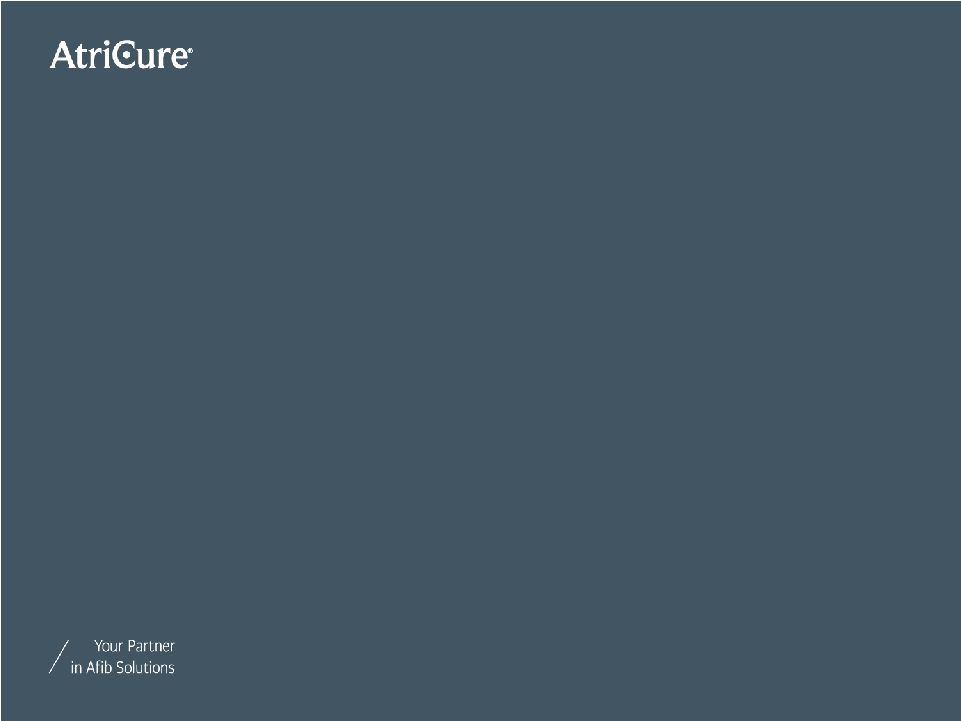 Investor Presentation
January 2015
Exhibit 99.2 |
| 2
Forward Looking Statements/Non-GAAP Measures
This
presentation
contains
“forward-looking
statements”
within
the
meaning
of
the
Private
Securities
Litigation
Reform
Act
of
1995.
Forward-
looking
statements
include
statements
that
address
activities,
events
or
developments
that
AtriCure
expects,
believes
or
anticipates
will
or
may
occur
in
the
future,
such
as
earnings
estimates
(including
projections
and
guidance),
other
predictions
of
financial
performance,
launches
by
AtriCure
of
new
products
and
market
acceptance
of
AtriCure’s
products.
Forward-looking
statements
are
based
on
AtriCure’s
experience
and
perception
of
current
conditions,
trends,
expected
future
developments
and
other
factors
it
believes
are
appropriate
under
the
circumstances
and
are
subject
to
numerous
risks
and
uncertainties,
many
of
which
are
beyond
AtriCure’s
control.
These
risks
and
uncertainties
include
the
rate
and
degree
of
market
acceptance
of
AtriCure’s
products,
AtriCure’s
ability
to
develop
and
market
new
and
enhanced
products,
AtriCure’s
ability
to
retain
and
attract
key
employees,
the
timing
of
and
ability
to
obtain
and
maintain
regulatory
clearances
and
approvals
for
its
products,
the
timing
of
and
ability
to
obtain
reimbursement
of
procedures
utilizing
AtriCure’s
products,
AtriCure’s
ability
to
continue
to
be
in
compliance
with
applicable
U.S.
federal
and
state
and
foreign
government
laws
and
regulations,
AtriCure’s
ability
to
consummate
acquisitions
or,
if
consummated,
to
successfully
integrate
acquired
businesses
into
AtriCure’s
operations,
AtriCure’s
ability
to
recognize
the
benefits
of
acquisitions,
including
potential
synergies
and
cost
savings,
failure
of
an
acquisition
or
acquired
company
to
achieve
its
plans
and
objectives
generally,
risk
that
proposed
or
consummated
acquisitions
may
disrupt
operations
or
pose
difficulties
in
employee
retention
or
otherwise
affect
financial
or
operating
results,
competition
from
existing
and
new
products
and
procedures,
including
the
development
of
drug
or
catheter-based
technologies,
or
AtriCure’s
ability
to
effectively
react
to
other
risks
and
uncertainties
described
from
time
to
time
in
AtriCure’s
SEC
filings,
such
as
fluctuation
of
quarterly
financial
results,
fluctuations
in
exchange
rates
for
future
sales
denominated
in
foreign
currency,
which
represent
a
majority
of
AtriCure’s
sales
outside
of
the
United
States,
reliance
on
third
party
manufacturers
and
suppliers,
litigation
or
other
proceedings,
government
regulation
and
stock
price
volatility.
AtriCure
does
not
guarantee
any
forward-looking
statement,
and
actual
results
may
differ
materially
from
those
projected.
AtriCure
undertakes
no
obligation
to
publicly
update
any
forward-looking
statement,
whether
as
a
result
of
new
information,
future
events
or
otherwise.
A
further
list
and
description
of
risks,
uncertainties
and
other
matters
can
be
found
in
our
Annual Reports on
Form 10-K and Quarterly Reports on Form 10-Q..
This
presentation
includes
the
use
of
non-GAAP
measures.
Reference
AtriCure’s
Form
8-K
filings
which
include
the
furnishing
of
our
earnings releases
for a reconciliation to the related GAAP measures. |
 3
Vision
AtriCure seeks to develop solutions
for and become a leader in the
treatment of Atrial Fibrillation (Afib)
and left atrial appendage (LAA)
management for stroke reduction |
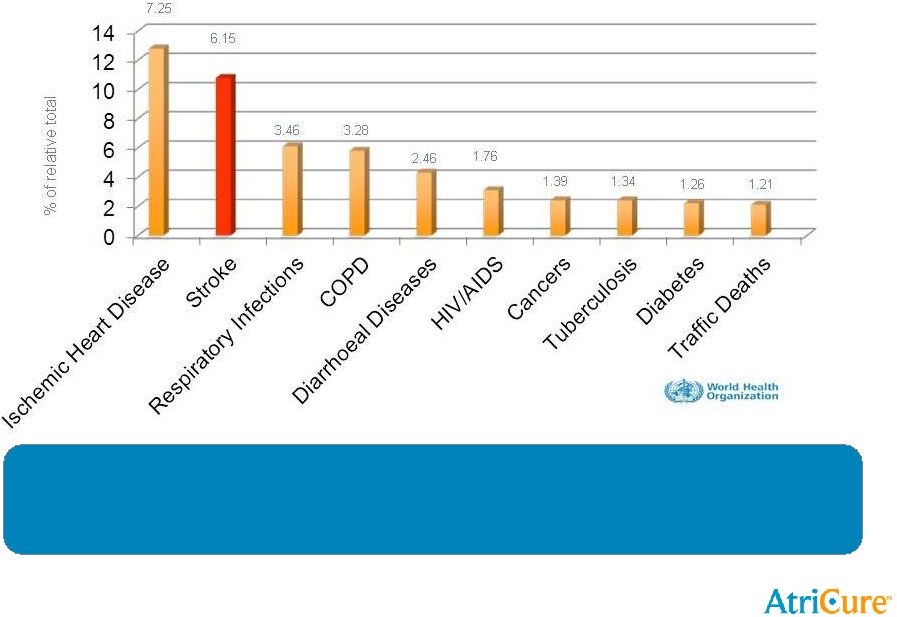 4
Top 10 disease related deaths worldwide
Afib is the second leading cause of stroke! |
| 5
Key Takeaway Messages
•
Atrial Fibrillation is a health problem of epidemic proportions
•
Only 27% of all surgical patients with AF are treated leaving a big opportunity for
treatment
1
•
Many current therapies such as anti-arrhythmic medications are
ineffective •
The Cox-Maze IV procedure is very effective at treating Afib
•
Patients
with
Afib
on
average
4-6
times
more
likely
to
have
a
stroke
2
•
Large,
under-penetrated
market
(10M+
people
globally
–
conservative
estimate)
•
$26 Billion annual health economic burden from Afib in the U.S. alone
AND ATRICURE IS POISED FOR SUCCESS …
1
Circulation:
Cardiovascular
Quality
and
Outcomes.
Estimation
of
Total
Incremental
Health
Care
Costs
in
Patients
With
Atrial
Fibrillation
in
the
United
States.
Michael
H.
Kim
et
al.
2
.http://www.ninds.nih.gov/disorders/atrial_fibrillation_and_strok
e/atrial_fibrillation_and_stroke.htm |
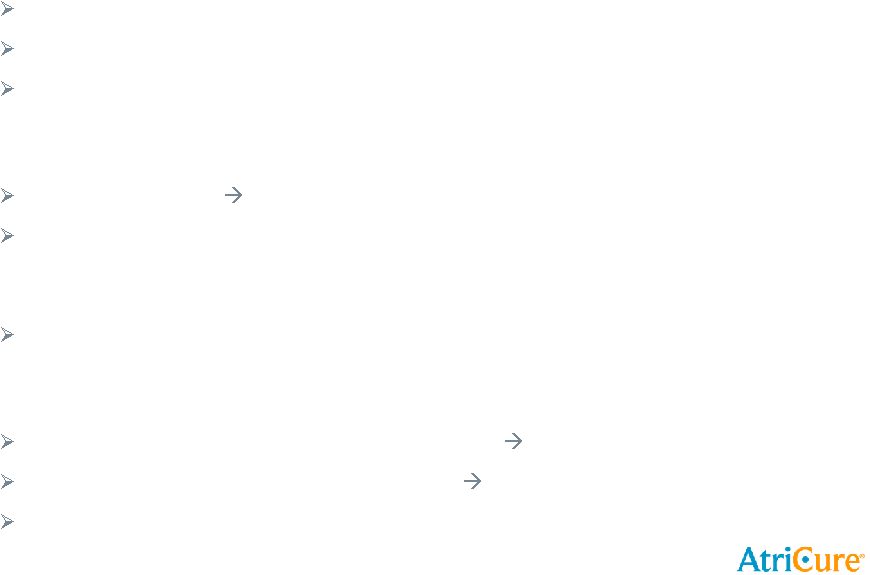 6
•
The leading global player in the surgical Afib market
Only FDA-approved device for surgical treatment of Afib
Broad and deep product portfolio with deepest IP in the field
World-class training
•
Strong and Consistent Revenue Growth and Gross Margins
17% growth in 2014
31% growth in 2014; organic growth of close to 20%
Expect 14-16% growth in 2015
-
weakening
Euro
impacting
business
–
guidance
would
have
been
higher
with
a
flat
exchange
rate from 2014
Gross Margins 70% in 2014 and on path to 75% over five years
•
Growth
Short
Term
=
Open
Ablation
+
Clip
+
International
Education,
Awareness, Training
Long
Term
=
MIS
+
MIS
Clip
+
New
Products
Trials
Upside = MIS and International
AtriCure Is Poised For Growth |
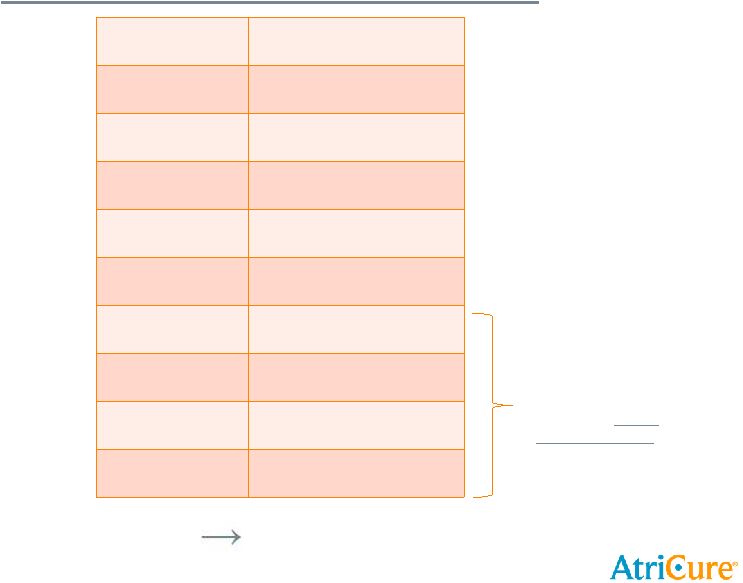 7
How Are We Doing?
A look at the last ten quarters:
2014
31% growth
Q3 2012
6% growth
Q4 2012
9% growth
Q1 2013
11% growth
Q2 2013
12% growth
Q3 2013
25% growth
Q4 2013
19% growth
Q1 2014
28% growth
Q2 2014
30% growth
Q3 2014
32% growth
Q4 2014
35% growth
Includes revenue from
12/31/13 Estech
acquisition
–
organic
revenue above 17% |
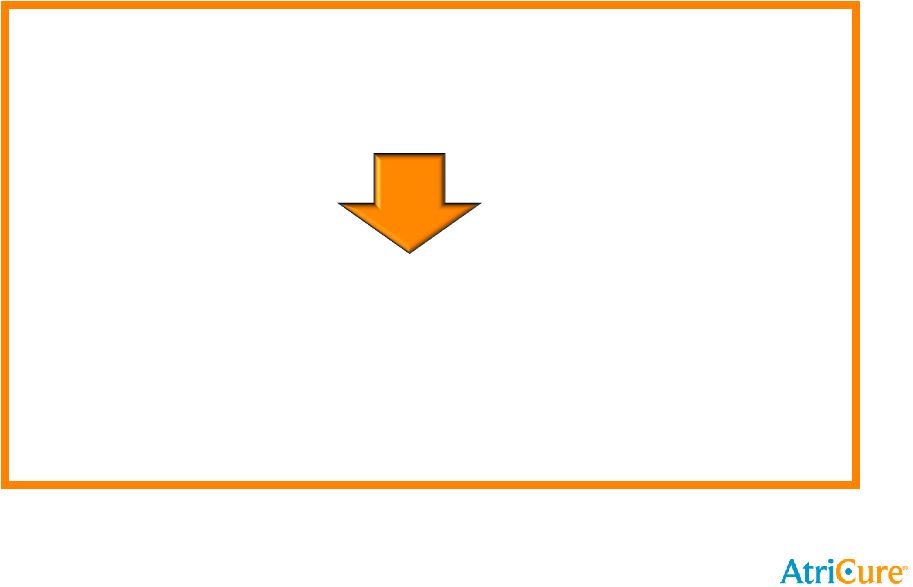 8
Be the recognized leader in Afib and
appendage management
Have improved the lives of more than
250,000 Afib patients and treated over
150,000 with Clips
By The End Of The Decade We Will… |
 9
AF Clinical Hierarchy |
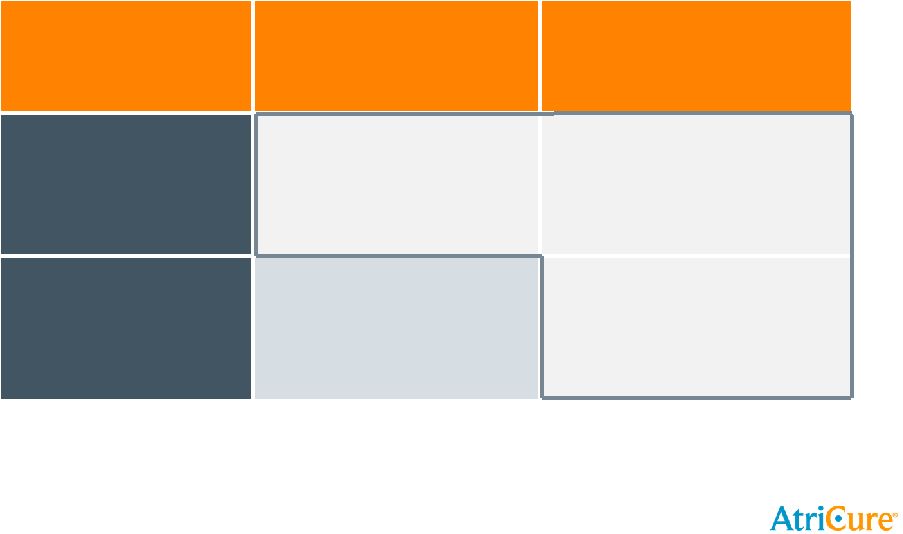 10
Emerging Clinical Paradigm
PAROXYSMAL
(INTERMITTENT)
NON-PAROXYSMAL
(CONTINUOUS)
OPEN
(CONCOMITANT)
PULMONARY VEIN
ISOLATION
(CLAMP or FUSION)
COMPLETE MAZE
STAND-ALONE
PULMONARY VEIN
ISOLATION
(CATHETER)
HYBRID
(SURGERY + EP PROCEDURE) |
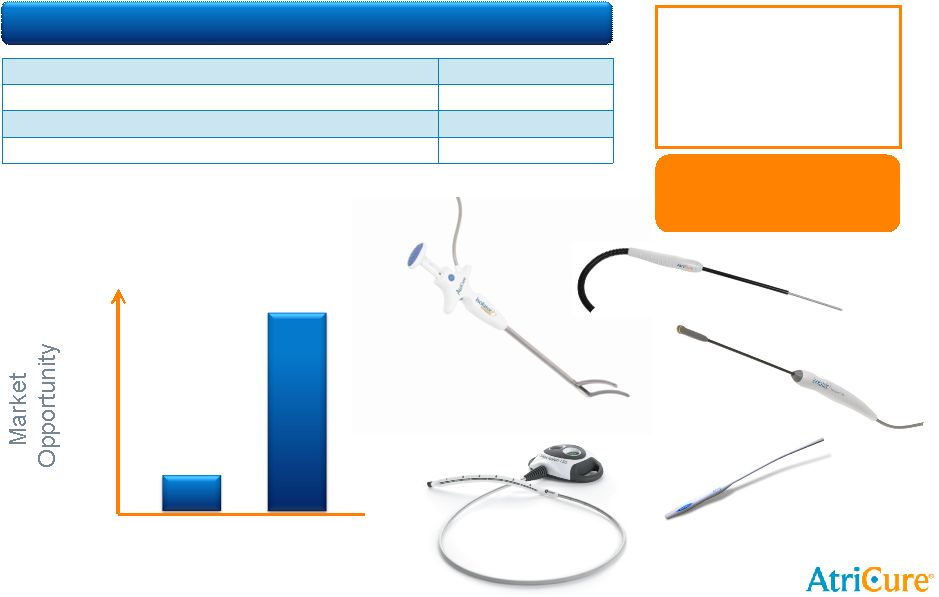 11
Ablation Global Market Opportunity –
Open
•
Labeling advantage in U.S.*
•
Best products
•
High gross margins
•
Education is key
•
Competition is large device
AtriCure has the only
on-label products for the
surgical treatment of Afib*
Open Ablation
$600M
$120M
Current
Market
Potential
Market
Estimated open heart surgeries per year
750,000
Estimated % that have Afib
33%
Estimated Afib patients undergoing surgery
250,000
Estimated
Market
Opportunity
–
Annual
$600,000,000
Source: AtriCure estimates
* PMA approved products include our OLL2 and OSL2
clamps., along with the ASU RF generator and ASB
switchbox; see AtriCure website for full indication language
|
 12
Ablation Global Market Opportunity –
Stand-alone
•
High reimbursement
•
High gross margins
•
Growing internationally
•
Development needed
•
Competition is start-ups
Developing Market
Trial Key to FDA
Approval for Afib
treatment
MIS / Stand Alone Ablation
Estimated
Afib
patients
–
E.U.
and
U.S.
Only
8,000,000
Estimated % drug refractory and symptomatic
50%
Subtotal
4,000,000
Estimated Persistent and Longstanding Persistent subset
50%
Subtotal -
Patients
2,000,000
Estimated
Market
Opportunity
–
Total
$20,000,000,000
Estimated % treated annually
5%
Estimated
Market
Opportunity
–
Annual
$1,000,000,000
$1B
$40M
Current
Market
Potential
Market
Source: AtriCure estimates |
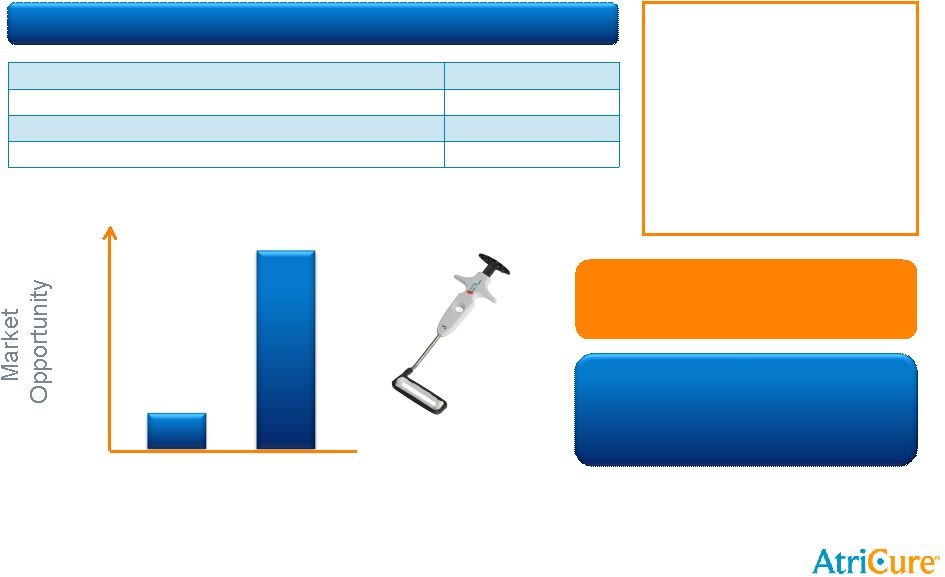 13
LAA Global Market Opportunity –
Open
•
Best in class LAA management
•
Superior
safety
-
No
adverse
events
•
Mechanical & Electrical Solution
•
Competition includes Tiger Paw,
staple, suture, ligature (endo loop)
•
2014
Revenue
-
$8.7M
•
2014
Revenue
-
$12.4M
(+44%)
4+ years of clinical experience
Over
43,000
clips
implanted
–
well
ahead of competitive products
Estimated Open heart surgeries per year
750,000
Estimated % that have Afib
33%
Estimated Afib patients undergoing surgery
250,000
Estimated
Market
Opportunity
–
Annual
$250,000,000
$250M
$10M
Current
Market
Potential
Market
UPSIDE:
Prophylactic treatment could more than
double this market
Open Clip
Source: AtriCure estimates |
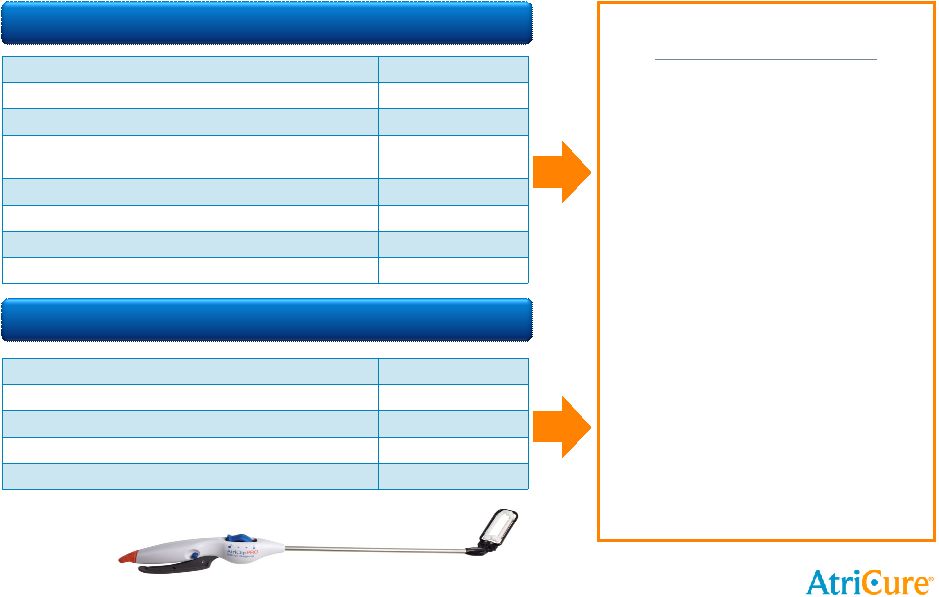 14
LAA Global Market Opportunity –
MIS (AtriClip
®
Pro)
One Product, Two Markets
Concomitant with MIS Ablation
•
Today’s market …will draft MIS growth
•
Virtually ALL revenue from MIS Clip is
for concomitant treatment along with
MIS ablation –
90% attach rate
Attractive sole therapy market
•
NEW market for us…
•
Today only a couple cases have been
done with OUR products “sole
therapy”…
a lot done percutaneous
•
Competition includes implants and EP
closure (without FDA approval)
•
Stroke trial key to success
Estimate of treatment resistant Afib patients
1,000,000
Estimated global revenue per device (all modes)
$5,000
Estimated
Market
Opportunity
–
Total
$5,000,000,000
Estimated % treated annually
10%
Estimated
Market
Opportunity
–
Annual
$500,000,000
Estimated
Afib
patients
–
E.U.
and
U.S.
Only
8,000,000
Estimated % drug refractory and symptomatic
50%
Subtotal
4,000,000
Estimated Persistent and Longstanding Persistent
subset
50%
Subtotal -
Patients
2,000,000
Estimated
Market
Opportunity
–
Total
$5,000,000,000
Estimated % treated annually
5%
Estimated
Market
Opportunity
–
Annual
$250,000,000
MIS Clip With Ablation
MIS Clip
Source: AtriCure estimates |
 15
Summary High-Level Plan
Market
Open is growth in short term
LAA Market is here now
Clinical data key to MIS growth
Short-Term (3-year)
Focus on commercial execution
Education, Education, Education
Cryo enhancements
Clip innovation
Long-Term (5-year)
Stroke trial success
DEEP trial success
LoLA on beating heart
SubX Clip
Financial
15%+ growth target
(17% in 2014 / 31% in 2014)
75% Gross Margin Target
(70% 2014)
Strategic Focus |
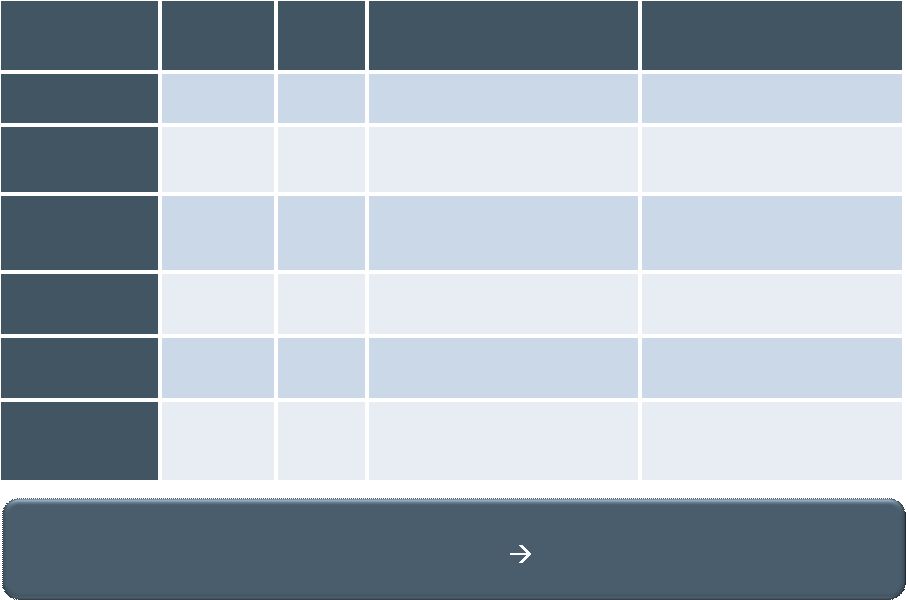 16
Business Overview -
Diversified and Growing Portfolio
Focus Areas
Preliminary
2014 Growth
Global
Market
Size
Keys to Success
Current Trials
Open Ablation
(Concomitant)
$44.7M U.S.
+18%
$600M
Annually
•
Education and awareness
•
Conversions and add-on sales
PMA Post Approval Study
(350 Patients; Five Years)
Open Clip
$16.7M
U.S.
+54%
$250M
Annually
•
Education and awareness
•
Tie to ablation growth
Sponsored Investigator Study Design
Underway
MIS Ablation
$16.0M U.S.
+18%
$20B total
$1B+
Annually
•
Trial
•
Collaborative care
•
Integration of Estech
IDE Staged DEEP (Hybrid)
Pivotal Approved
220 Patients; 25 sites
1, 2 and 3 year follow-up
MIS Clip
Included
In Open Clip
line above
$5B total
$500M+
Annually
•
Awareness
•
Trial
Stroke Safety Feasibility Study
Approved
30 patients, 7 sites
International
$27.3M
+39%
Included
above
•
Market expansion
•
Reimbursement
•
Coverage
Involvement Above and Several E.U.
Studies in Process
Overall
$107.5M
+31%
$1B+
Annually
$20B+
Total
2015 Revenue Guidance:
$122.5 -
$124.5 million
14-16% growth
(Reflects estimated $1.6 million adverse currency impact due to weakening Euro)
|
 17
Growth Strategy: Overview
Expand Open Heart Sales
Penetrate LAA Opportunity
Build MIS Platform
International Expansion
•
Leverage Afib indication
•
Increased training and education
•
Capitalize on sales force
•
Afib Program Development
•
Capitalize on investments in sales team
•
Geographic expansion and new products
•
Increase support for distributors
•
Penetrate concomitant ablations
•
Validate stroke prevention with trial
•
Support existing MIS surgeons
•
Support Staged DEEP AF trial
•
Integrate Estech Acquisition
AtriCure
is
the
only
company
with
FDA
approval
to
surgically
treat
the
Afib
disease
state
and
is
a
leader
in
the emerging market of LAA exclusion |
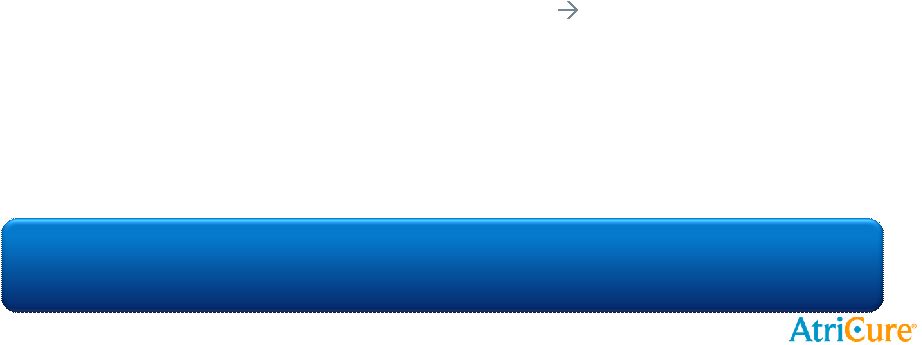 18
•
Highly experienced sales and marketing team
•
45 U.S. sales territories; additional clinical team of 25
–
Up from 35 and 12 two years ago respectively
–
Adding 5+ territories in 2015
•
E.U. subsidiary and 30 countries (generate ~25% of revenue)
–
Direct presence in Germany, France, BENELUX
over 10 people
–
Estech brings strong presence in E.U.
–
Well-established international network of independent distributors
–
Japan, China, Eastern Europe, UK, Italy, Russia
Robust Commercial Infrastructure
AtriCure
has
established
a
strong
commercial
infrastructure
which
will
drive
superior
growth
going
forward |
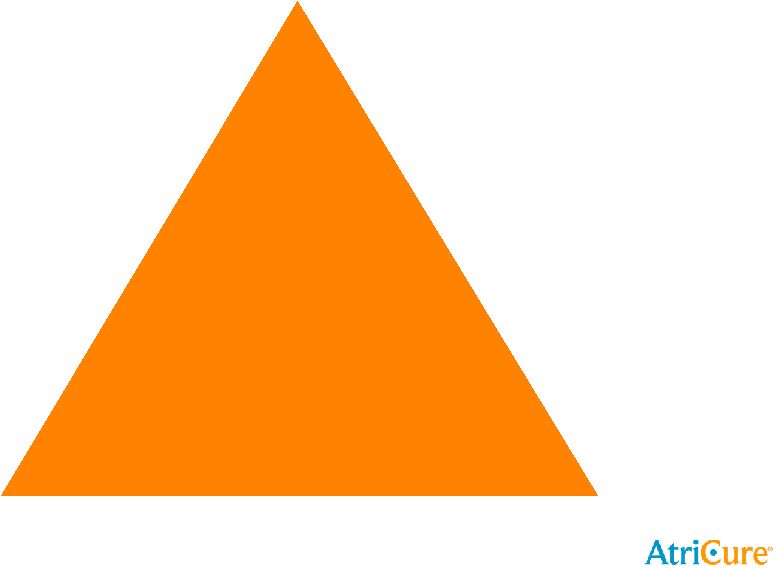 19
Other Key Investments For Long-term Growth
Innovation
Education
Clinical Science
AtriCure
is a leading Afib
solutions partner,
passionately
focused on reducing
the global Afib
epidemic and
healing the lives of
those affected. |
 20
Education and Training Focus
•
Robust training program
•
Course designed by Dr. James Cox
•
Leading KOL Education Steering Committee
•
700+ unique accounts and more than 1500
surgeons trained on the MAZE IV™
procedure
•
Over 400 courses completed
•
International Expansion Underway |
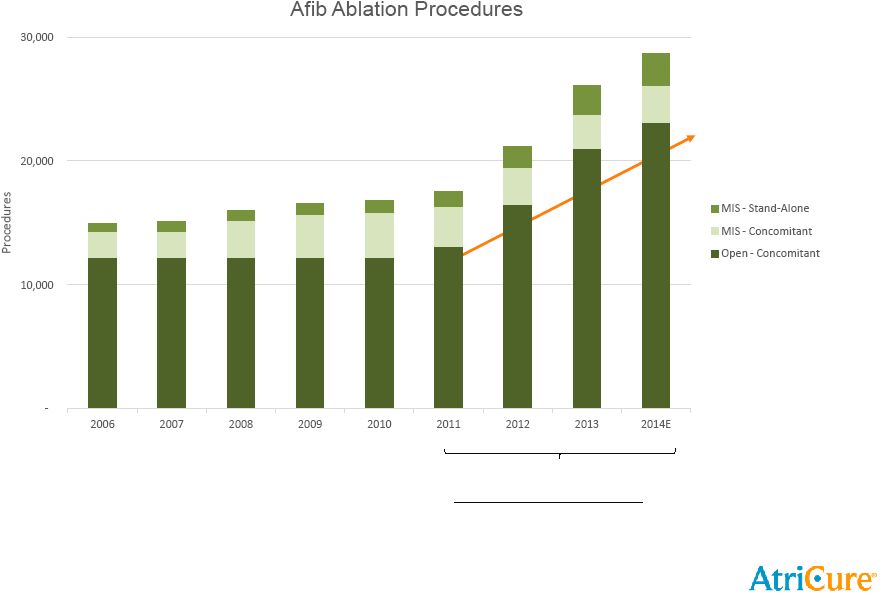 21
Impact of Label and Educational Programs
Growth of Open Ablation due to
ATRC Educational Programs
•
FDA
Approval
of
Synergy™
System
in
December
2011
for
the
treatment
of
persistent
Afib
•
Have trained ~62% of cardiac surgeons in the U.S.; 38% more to go!
Sources: STS Adult Cardiac
Surgery
Database
-
2006-
2014;
Ad
2014
-
Ann
Thor
Surg
Vol
96
-
763-769;
company estimates |
 22
Evidence-Based Benefits of AtriCure Technology
•
$15M+ annual R&D expense –
includes clinical trial expense
•
Over 100 peer-reviewed publications to date
•
Post Approval Study –
350 patients; 50 sites; 5 years with 3 year follow-up
•
EXCLUDE Trial demonstrating safety and efficacy of AtriClip System
•
Staged DEEP Protocol –
FDA-approved hybrid trial
•
Stroke trial design underway
•
International trials –
reimbursement focus
•
Combined with Estech, 185 issued and nearly 50 patents pending
•
Compelling animal and early clinical data with Estech Fusion System
Commitment to Clinical Science |
 23
Financial Snapshot
•
Approximately
$68.5
million
in
cash
and
investments
at
12/31/2014
•
No debt outstanding
•
Approximately 27.5 million shares outstanding
Revenue and Gross Margin
Balance Sheet and Share Statistics
•
2014 Total Revenue Growth: 31%
•
2014 US Growth: 29%
•
2014 OUS Growth: 39%
•
Four Year CAGR of 16%
•
Gross Margins 70-73%, with expansion
opportunity |
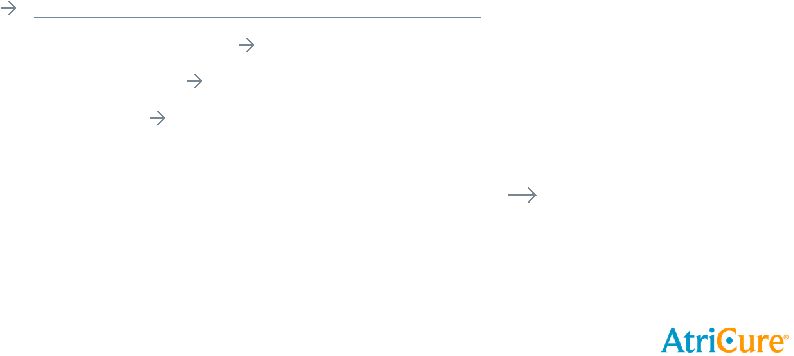 24
Positioned for Success
•
Strong and growing revenue base
•
2014 Revenue: $81.9 million (17% growth)
•
2014 Revenue (expected): $107.5 million (31% growth; ~ 20% organic growth)
•
2015
Revenue
(guidance):
$122.5
-
$124.5
million
(14%
to
16%
growth,
even
with
a
weak
Euro)
•
Accelerating revenue growth
•
Open
only
device
FDA-approved
for
surgical
treatment
of
Afib
•
Minimally
Invasive
Solutions
(MIS)
trial,
Estech
acquisition,
education
and
clinical
data
key
•
Left
Atrial
Appendage
(LAA)
open
and
future
trial
•
International
Expansion
improve
share
and
enter
new
markets
•
Opportunity
for
expanding
gross
margins
path
to
75%+ |
 |
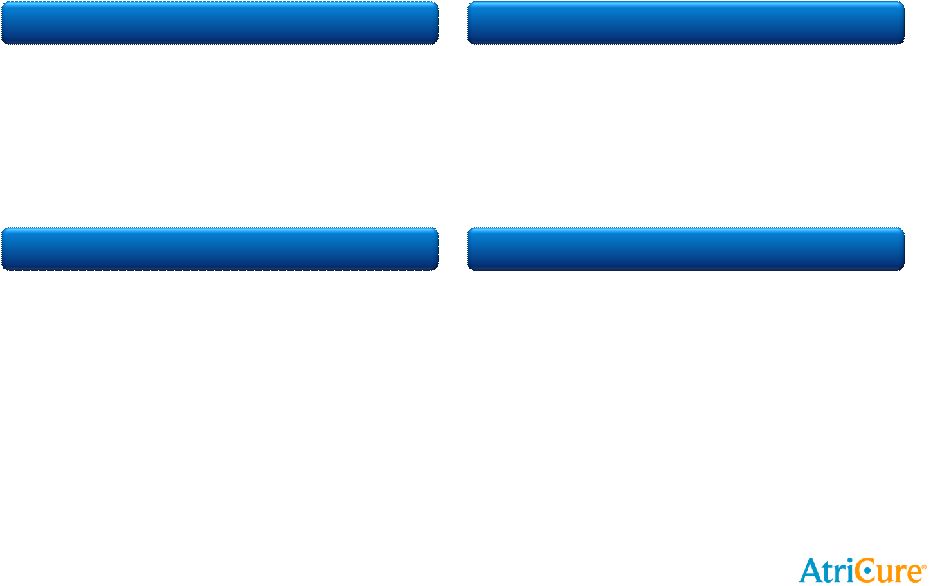 26
Atrial Fibrillation Overview
Condition Overview
Continuum of Care
•
Abnormal electrical impulses cause the upper
chambers of the heart to quiver at rapid rates of 400
to 600 BPM
•
Frequently associated with cardiovascular disease,
in particular hypertension, congestive heart failure,
coronary artery disease, etc.
Effects
•
Causes blood in the atria to become static,
increasing the risk of blood clot formation, stroke,
and other serious complications
•
Symptoms include heart palpitations, dizziness,
fatigue and shortness of breath, and these
symptoms can be debilitating / life threatening
Types
•
Paroxysmal: rapid heart rate begins and stops
suddenly
lasting
24
hours
–
1
week
•
Persistent: abnormal heart rate continuing for more
than a week
•
Permanent: normal heart rhythm can't be restored;
often the result of paroxysmal and persistent Afib
becoming more frequent
•
Initial treatments include electrical cardioversion
(shock to return heart to normal rhythm) and
anticoagulant medicines such as warfarin
•
If persistent, anticoagulants are augmented by rate-
control medicines such as beta blockers
•
When drugs fail, MIS catheter ablation and open-
procedure surgical ablation are used to disrupt the
electric impulses that cause Afib |
 27
Afib Population: Large, Growing & Undertreated
(1)Miyasaka Y, et al. Circulation. 2006;114(2):119-125
(2)Lloyd-Jones D, et al. [published online ahead of print December 17, 2009].
Circulation. doi:10.1161/CIRCULATIONAHA.109.192667.
(3)Lloyd-Jones DM, et al. Circulation. 2004;110(9):1042-1046.
(4) Fuster V, et al. J Am Coll Cardiol. 2001;38(4):1231-12665
(5)
Benjamin EJ, et al. Circulation. 1998;98(10):946-952.
(6)
Kim M, et al. Circ Cardiovasc Qual Outcomes. 2011; 4:313-320
Afib affects over 5 million
in the U.S.
(1)
Significant costs to
healthcare system
•
U.S. prevalence projected to grow to 12-15 million by 2050
•
International prevalence is comparable to the U.S.
•
Most
common
sustained
cardiac
arrhythmia
(2)
•
Lifetime
risk
of
Afib:
~1
in
4
for
adults
40
years
of
age
(3)
Afib increases 5-fold the
risk of stroke
(4,5)
•
Afib
is
leading
cause
of
stroke
–
over
15%
in
U.S.
linked
to
Afib
(5)
•
Afib
results
in
early
mortality
and
cause
of
stroke
in
elderly
(4)
•
Afib-related
strokes
are
more
severe
(5)
Issues with non-surgical
treatment of Afib
•
Warfarin drug therapy has complications
•
Anti-arrhythmic drugs often not well-tolerated and ineffective
•
<3% of Afib patients are treated with catheter or surgical ablation
•
Direct
medical
costs
are
~73%
higher
in
Afib
patients
(6)
•
Net
incremental
cost
of
$8,705
per
patient
per
annum
(6)
•
U.S.
annual
incremental
cost
of
Afib
is
~$26.0
billion
(6) |
 28
Ablation Procedure Comparison
J Thorac Cardiovasc Surg 2012;-:1-6; J Am Coll Cardiol 2012;60:1921–9
|
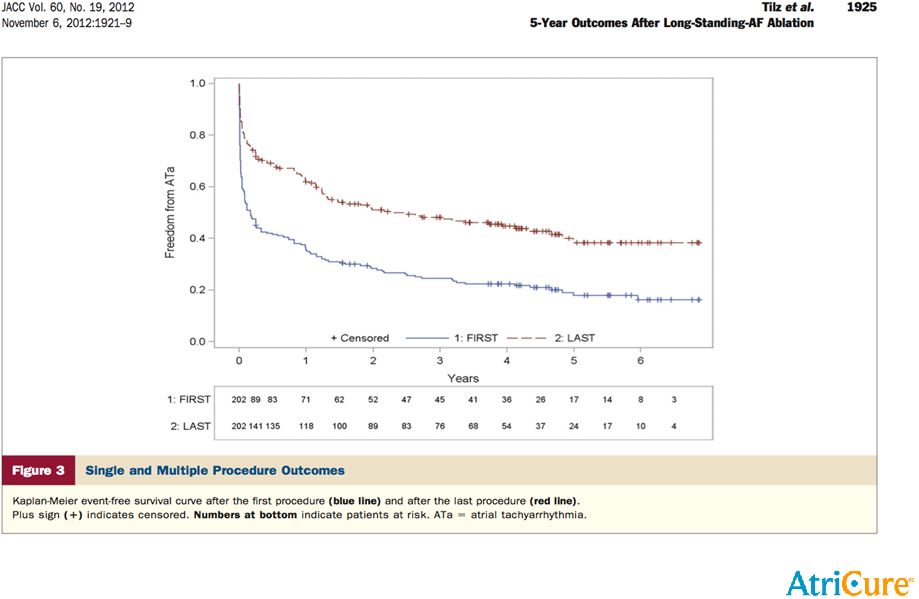 29
20% 1 procedure
45% 2.44 procedures
Catheter Ablation of Long-Standing Persistent Atrial Fibrillation
5-Year Outcomes of the Hamburg Sequential Ablation Strategy
|
 30
Maze IV |
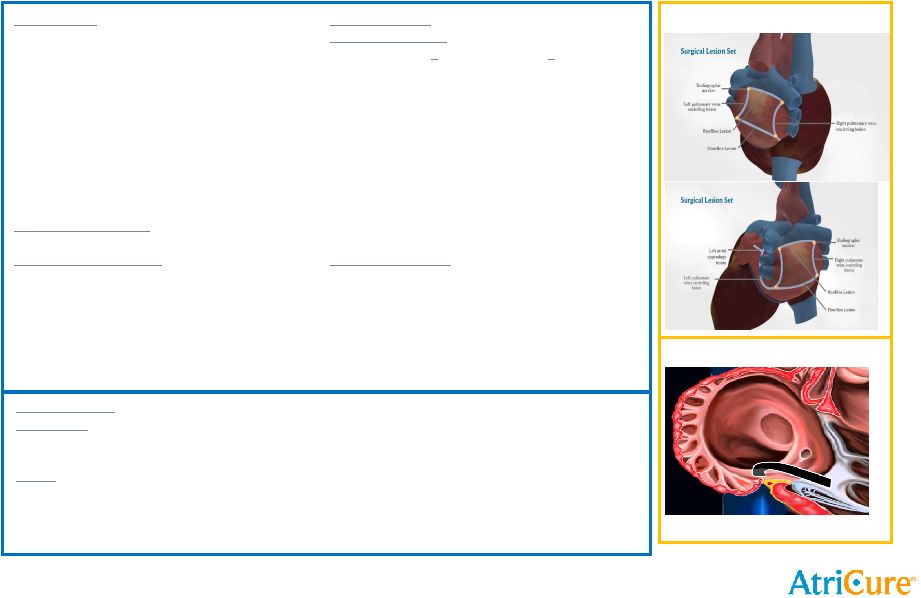 31
DEEP Pivotal Study (CP2014-1) Surgical Lesion Set
Endocardial Lesion Set
Cavo-tricuspid isthmus line
Study
Objective:
Establish
the
safety
and
effectiveness
of
a
dual
epicardial
and
endocardial
ablation
procedure
for
patients
presenting
with
Persistent
or
Longstanding
Persistent
Atrial
Fibrillation
utilizing
the
AtriCure
Bipolar
System
and
AtriClip
®
PRO
LAA
Exclusion
System
in
an
endoscopic
or
open
ablation
procedure,
followed
by
an
endocardial
mapping
and
ablation
procedure
utilizing
commercially
available
RF
based,
irrigated,
power
controlled,
ablation
catheters
for
endocardial
lesions.
The
endocardial
procedure
will
be
staged
to
occur
after
90
days
post
epicardial
surgical procedure.
Number of Subjects/Sites: 220 Subjects, 23 US/2 OUS
study locations
Lead Principal Investigators:
Kenneth Ellenbogen, MD, VCU
Vigneshwar Kasirajan, MD, VCU
Ali Khoynezhad, MD, Cedars Sinai
Paul J. Wang, MD, Stanford
Primary Endpoints:
Effectiveness:
Freedom
from
any
documented
AF,
atrial
flutter,
or
atrial
tachycardia
lasting
>30
seconds
in
duration
through
the
12
month
follow-up
visit
in
the
absence
of
Class
I
or
III
AADs
(with
the
exception
of
previously
failed
AADs
at
doses
not
exceeding
those
previously
failed).
Safety:
Composite
endpoint
consisting
of
predefined
Adverse
Events
that
are
adjudicated
by
the
CEC
to
be
serious
adverse
events
(SAEs)
and
related
to
the
AtriCure
Bipolar
System,
the
AtriClip
Pro
LAA
Exclusion
System,
within
30
days
of
the
epicardial
surgical
ablation
procedure,
or
within
7
days
of
the
index
endocardial
procedure,
or
within
7
days
after
a
repeat
endocardial
procedure
within
the
blanking
period.
Subject Population:
Key Inclusion Criteria:
•
Patient is >18 years of age and <
75 years
of age at time of consent.
•
Patient has symptomatic (e.g. palpitations,
shortness of breath, fatigue) Persistent Atrial
Fibrillation or Longstanding Persistent Atrial
Fibrillation refractory to a minimum of one Class I
or Class III AADs.
•
Patient may have had up to two (2) previously
failed catheter ablations to treat atrial fibrillation
using catheter ablation are eligible, if they
present with symptomatic Persistent or
Longstanding Persistent AF.
Key Exclusion Criteria:
•
Patient has a documented history of AF >10
years.
•
Patient has had an EP catheter ablation
procedure to treat atrial fibrillation within 6
months prior to signing consent. |
